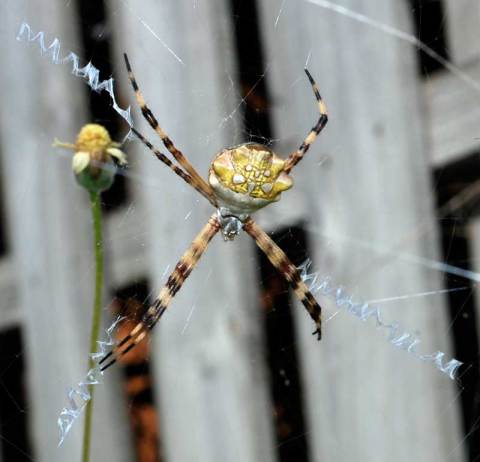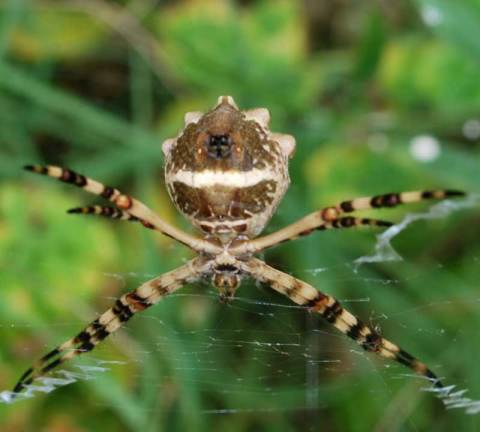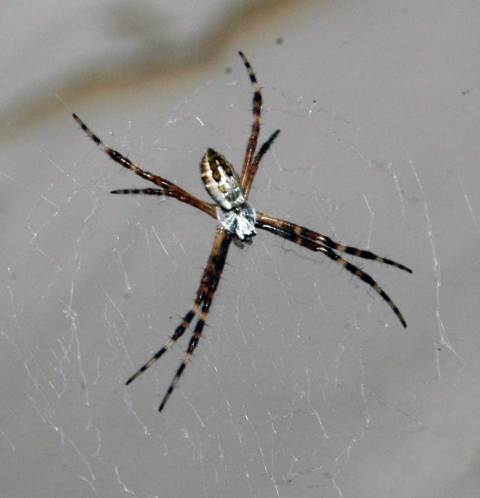I never finished the miniseries I had started last December on spiders found in and around my yard; here is the fourth installment, starring two species of orbweaver that are commonly encountered in gardens both in Florida and elsewhere. They are so common, in fact, that they have common names, unlike the vast majority of spiders: Argiope argentata is known as Silver Garden Orbweaver or Silver Argiope, while A. florida is known as the Florida argiope. Florida has two other Argiope species, A. aurantia and A. trifasciata, but I have yet to encounter them in my Florida back yard, so today’s post is just about “known species” to me.
One of the reasons I leave my Florida yard a bit unkempt is so that spiders, those efficient and abundant predators, can have more time to control any bad bugs that might be around. A neat and trim yard, with a beautiful lawn and well-defined flower beds and no overgrown bunch grasses or wildflower beds is one that requires chemical control of harmful insects (which also “controls” beneficial ones), and dozens of hours of mowing, weeding, trimming, clipping, hedging, and weed-whacking. I try to think that it’s not just my own laziness that urges me instead to let nature take her course. Instead, it’s principle: I do what I can to maintain a semblance of ecology in my garden (a la Grissell’s idea of garden ecology). If said principle happens to result in less “work” for me, and more photographic and entomological opportunities, well, so be it.
So that’s why I haven’t yet trimmed my muhly grass, despite the fact that its stalks and blooms are yellow, not purple, and why I’ve left the “weedy” species (Bidens alba, Richardia grandiflora, etc.) around the fences unwhacked: these “unsightly” areas of overgrowth allow many more hiding places for insects, and attachment sites for spiderwebs. And as a result I’ve got literally dozens of spiders (Argiope species, Leucauge species, Gasteracantha species, and more) helping me control the flies and other annoyances that might otherwise rise to “treatment required” levels.
Here, though, without further ado, are the pictures of the two Argiope spiders. A. argentata, the more commonly encountered spider, first:
These are not small spiders; this one is at least half an inch long, but remember, spider measurements exclude the leg length. If you add in the legs, it’s two inches across; if you add in the “stabilimenta” woven into the web, the visual impression of this spider is daunting, indeed.
Here’s a picture of one of the business ends, the spinnerets on the abdomen:
The liquid silk that flows from the silk glands hardens very soon after flowing through these nozzles; it’s the various chemical constituency of the silk combined with the treatment it receives post-spinneret that determines whether it’s “sticky” (viscid) or not. The function of the stabilimentum isn’t known for certain, but some experiments show that birds are slightly better at avoiding webs with stabilimenta than those without. And a bird flying into the web, rather than being a tasty prey item for this spider, just means that she has to rebuild her web.
Back in 1982, entomologist Thomas Eisner and ornithologist Steven Nowicki tested that hypothesis at Archbold Biological Station in central Florida demonstrating that before dawn, when birds are not yet active, both marked and unmarked webs survive at equal rates: about 80%. But after dawn, the unmarked webs started disappearing, until by noon only 8 percent of them remained, while fully 60 percent of the marked ones, those with “stabilimenta,” remained intact. And while they had only one data point of a bird flying into a web (an Eastern Towhee encountering an unmarked web), it remains the most convincing explanation of the function of this visual marker.
The other type of Argiope spider I found in my garden was actually photographed last year, in December, but I didn’t realize what it was until I tried to determine for sure what today’s photos (of A. argentata) were. Argiope florida looks pretty similar to A. argentata, but the abdomen of the latter has a golden back end with a few (6, in this case, although that might be variable) silver triangles there, while the former has three long projections of silver along its back half, as you can see in the fuzzy photo below:
- as implied by the name, the stabilimentum strengthens or stabilizes the web (Eisner and Nowicki disproved this hypothesis by comparing the strength of de-stabilimentized webs (with their stabilimenta dissolved by alcohol) with those that still had them and finding no difference)
- bird avoidance (the conclusion reached by Eisner and Nowicki)
- insect attractant
- camouflage for the spider itself (the conclusion favored by Marshall and Edwards, according to “recent research”)
Whatever the case, the debate is fun, and so is finding and photographing these wonderful animals.
References
Eisner, T. 2003. For Love of Insects. Cambridge, MA: Belknap/Harvard.
Marshall, S., & G.B. Edwards. 2008 Florida’s Fabulous Spiders, 4th ed. Hawaiian Gardens, CA: World Publications.



